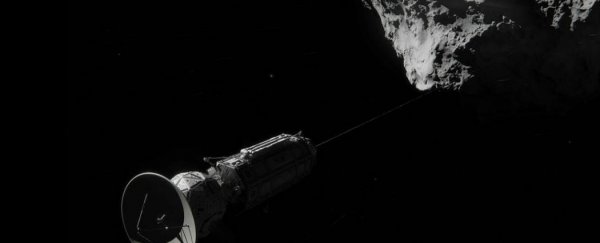Travelling across the vast distances of space requires a lot of time and a lot of fuel, which is why NASA's latest spacecraft concept takes a different approach: hitching rides from passing comets as they rocket their way around the galaxies. It's the rather brilliant idea behind the new Comet Hitchhiker, presented for consideration this week at the American Institute of Aeronautics and Astronautics' Space Conference.
By using comets and asteroids for propulsion, the Comet Hitchhiker could reach speeds of at least 35,405 km/h (22,000 miles/h), enough to get started on some serious space exploration. In fact, the idea behind the spacecraft is to make it easier to land on and examine these deep-space rocks, making the whole planning process more straightforward for scientists than it was with the Philae Lander - the combination of a low gravitational pull and incredible speeds means landing a craft on a comet presents all kinds of challenges.
"Hitchhiking a celestial body is not as simple as sticking out your thumb, because it flies at an astronomical speed and it won't stop to pick you up. Instead of a thumb, our idea is to use a harpoon and a tether," says Masahiro Ono, the principal investigator and project lead at NASA's Jet Propulsion Laboratory in California. This tether system would be reusable and wouldn't require propellant for the landing and taking off stages.
The actual technique is similar to the one a fisherman would use. Once close to a comet, the Hitchhiker would use a tether and harpoon to get attached to the rock, allowing itself to get pulled along and releasing the tether slowly (keeping it at medium tension, just as you would with a fishing line). Energy would be harvested as the spacecraft brakes, and it would then slowly reel itself into the comet as the two velocities begin to match.
Energy collected from the landing process could then be used to slingshot the spacecraft off to the next port of call - the next piece of debris careering through the empty vacuum of space. The engineering team behind Comet Hitchhiker think between five and 10 comets could be 'caught' in this way on each single mission, though as with real-life hitchhiking, the spacecraft would have to be content with travelling wherever the comet was heading.
NASA's scientists think Comet Hitchhiker could make it to Pluto in around six years, which is an impressive pace, and it would still have some energy left as well: at that point, it would be able to act as a distant refuelling point for other spacecraft.
For this to work, engineers need some extremely durable equipment that doesn't yet exist - namely a 100-km-long carbon nanotube tether and a harpoon made from diamond - but they're hopeful of making progress in the years ahead. The next step is small-scale and virtual testing of the concept in the NASA labs.
